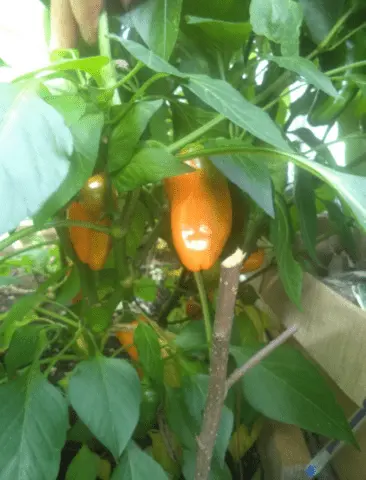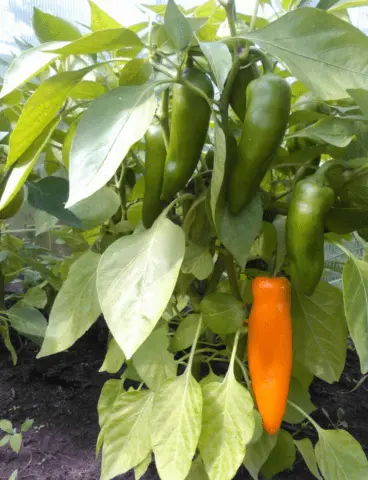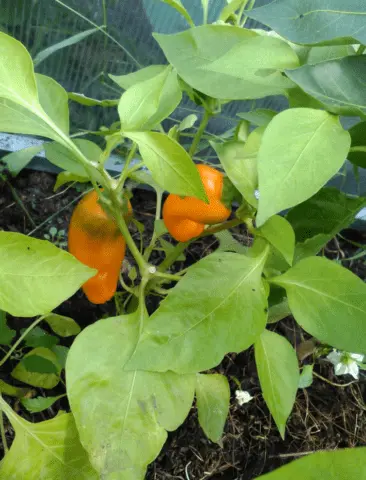Contents
Pepper Chanterelle is a variety series that includes several varieties. It is characterized by high resistance to adverse weather conditions, which makes it possible to grow a crop in most regions. The taste is excellent, the aroma is rich, pleasant.
The story of
Chanterelle is a variety of sweet pepper (Capsicum annuum L.), bred by breeders (Gavrish S.F., Nekrasova Yu.V. and Rudneva S.N.). Refers to hybrids of the first generation (F1). An application for admission to the register of breeding achievements was filed in 2001, registration took place in 2002.
In recent years, several more varieties have been bred:
- Sweet pepper Chanterelle yellow. The variety was included in the register in 2017.
- Sweet pepper Chanterelle red. The variety was also included in the State Register in 2017.
- The fox is orange. The variety is included in the register after three years (in 2020).
Description of pepper varieties Chanterelle
The Chanterelle variety series is represented by several varieties that differ in color, size and taste of fruits. A description of each variety is provided below.
Weight, color and shape of fruits
Sweet pepper Chanterelle F1 produces cone-shaped fruits with a smooth, glossy surface. The color at the stage of technical ripeness is green, as it ripens it becomes orange. The fruits are small, cone-shaped, weight on average 25-45 g, wall thickness 5-6 mm. Two nests with seeds are noticeable on the cut, but it is useless to collect them. It will not be possible to get fertile offspring, since the variety is a hybrid. The taste is very good, the aroma is bright, pronounced.
In the description of sweet pepper Chanterelle red, the main parameters and characteristics are given:
- fruit weight – 20-40 g;
- wall thickness – 4-5 mm;
- color – dark red;
- shape – cone-shaped, drooping;
- the surface is smooth, with a pronounced gloss;
- taste is pleasant.

The culture belongs to medium early, the crop has time to ripen on the branches
The main characteristics of orange chanterelle pepper:
- weight – 50-55 g;
- wall thickness – 3-4 mm;
- the color of ripe specimens is orange;
- shape – cone-shaped, drooping;
- surface – smooth, finely ribbed, with a low gloss;
- taste is excellent.
The yellow variety is also in demand among vegetable growers and buyers. It has a pleasant taste and a special aroma. Description of the fruit variety Chanterelle yellow:
- weight – 20-40 g;
- wall thickness – 4-5 mm;
- the color of ripe fruits is bright yellow;
- shape – cone-shaped, drooping;
- the surface is smooth, finely ribbed, with a pronounced gloss.
The height and size of the bush
The size of the bushes, the appearance of the leaves and shoots also differ depending on the variety:
- Pepper Chanterelle F1 has semi-spreading bushes, semi-stem type. The height is small, the leaves are medium in size, green in color, with a wrinkled surface.
- In the variety Chanterelle red, the bushes are semi-spreading, of medium height. The leaves are small, the color is dark green, there is practically no wrinkling.
- Bush varieties Chanterelle orange sprawling and very tall. The leaves are medium in size, large, saturated green in color, the surface is slightly wrinkled.
- Yellow Chanterelle peppers have medium-sized, semi-spreading bushes. The leaves are small, the color is dark green, the surface is wrinkled.
Characteristics of Chanterelle pepper
Chanterelle pepper is quite fruitful – with the right agricultural technology, at least 2 kg of fruit can be harvested per square meter. They ripen relatively quickly, so they have time to keep up on the branch.
Yield of chanterelle pepper
The yield of the variety series Chanterelle is moderately high. On average, 1-2 kg of ripe fruits are harvested from 2,5 square meter. Peppers have time to ripen on the vine. If they need to be transported over long distances, it is better to harvest the crop at the stage of technical ripeness, when the fruits are still green.

A change in the color of the fruit indicates their ripening
Fruiting terms
All varieties are mid-early or mid-season. From the moment of planting to the stage of technical ripeness, 130-135 days pass. Thus, even taking into account the time during which shoots appear from seeds, the crop ripening period is no more than 4,5 months.
Disease resistance
With proper care, Chanterelle pepper rarely suffers from diseases. But due to excess moisture, heavy soil, poor ventilation, plants can be affected by black leg (at the seedling stage), fusarium, gray rot or late blight. Therefore, it is necessary to follow the rules of agricultural technology and carry out 1-2 preventive treatments.
Growing regions
Chanterelle pepper adapts well to different climatic conditions. Therefore, all varieties can be grown in most regions:
- middle lane;
- the Volga region;
- Northwest;
- Chernozem region;
- southern regions;
- The Urals;
- Western and Eastern Siberia;
- Far East.
Advantages and disadvantages
Chanterelle pepper was bred relatively recently – the last representative of the variety series appeared in 2020. However, the culture has become quite popular – almost all reviews about it are positive. Summer residents note a stable yield.

The fruits are small, but very tasty and fragrant.
Pros:
- stable yield;
- excellent taste;
- fruits of different colors;
- few seeds, easy to clean;
- bushes are quite compact;
- resistance to certain diseases;
- transportability.
Cons:
- small peppers;
- seed germination is low – up to 33%;
- quality seed is not always available.
Peculiarities of growing
The rules for growing chanterelle pepper are standard. But it must be taken into account that the germination rate is low. Seedlings do not tolerate picking. Therefore, it should be grown immediately in separate containers, planting several pieces.
When and how to plant seedlings
Seeds after planting germinate within 2-3 weeks. Therefore, they should be sown in the second half of February. To do this, prepare fertile soil and peat pots or tablets. The seeds are pre-etched for 20-30 minutes in a 1% solution of potassium permanganate, then placed in a growth stimulator overnight and germinated on wet gauze.
Then 4-5 pieces are planted in a tablet or pot (depth 1 cm). Grown in warm (25-27 degrees) and humid conditions (under the film). After the emergence of seedlings, they are allowed to grow a little, and only a strong seedling is left, and the rest are pinched. During cultivation, be sure to turn on the backlight. Two weeks before transplanting, seedlings begin to harden.
Transplantation in open ground
The transfer of Chanterelle pepper seedlings to open ground is planned for the second half of May. The planting pattern for medium-sized varieties is 70 * 35 cm, and for tall ones – 70 * 45 cm. The depth of the holes should be such that the roots fit freely and the root collar remains flush with the surface.
Care instructions
Agrotechnics of cultivation is standard. Bushes need regular watering (2-3 times a week) and feeding (every 10 days). Top dressing is better to alternate – complex mineral with organic. The soil is periodically loosened, weeding is done. After transplanting, it is necessary to lay a layer of mulch 8-10 cm high. As the bushes grow, they are tied to a pre-installed support.

Regular top dressing allows you to get a consistently high yield
Disease and Pest Prevention
To prevent fungal infections, seedlings a few days after transplantation are recommended to be treated with any fungicide:
- Bordeaux liquid;
- “Maksim”;
- “RAW”;
- “Quadris”;
- “Ridomil Gold”;
- “Profit”.
If aphids, spider mites or other pests appear on the pepper, the bushes need to be treated with folk remedies, for example, infusion of wormwood, onion peel, garlic. In extreme cases, use insecticides:
- “Inta-Vir”;
- “Agravertin”;
- “Decis”;
- “Karate”;
- “Fufanon”;
- “Vertimek” and others.
Conclusion
Chanterelle pepper gives small fruits, but they have time to ripen in the climatic conditions of different regions. Taste qualities are on top, as evidenced by the reviews of summer residents. Such pepper can be used both fresh and for harvesting for the winter.









